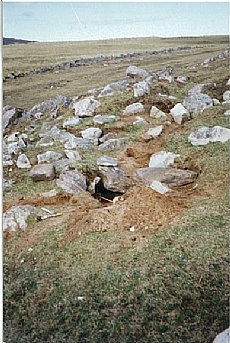Loch Borralie Iron Age Burial Cairn
01 June 2019
- News Type:
- Site of the Month

In 1998, burrowing by rabbits dislodged a human skull from beneath a cairn at Loch Borralie in Sutherland. An archaeological evaluation of the burial cairn was consequently undertaken by GUARD in 2000 under the direction of Historic Scotland. This excavation revealed that the cairn was multi-phased and recovered remains from two extended burials, one of which was radiocarbon dated to 40 BC - AD 130, and thus was of Iron Age date.

The cairn was situated on a peninsular between Balnakeil Bay and the Kyle of Durness in an area containing a number of archaeological remains. The cairn was roughly sub-rectangular in shape and measured 7m N-S by 3.5m E-W. Excavation proved it to have a maximum height of 1.2m and to be composed of large sub-angular and sub-rounded rocks. The first phase of activity was the construction of a low primary cairn of stone and earth. The full extent and depth of this was unknown but it appeared to sit on a natural gravel sand deposit. On top of this primary cairn was the burial of skeleton 1, which, apart from the absence of its limbs, was relatively well preserved. Two pieces of struck quartz were discovered beneath it, and a large stone had been placed immediately east of its head. This burial was sealed by a red-brown layer of sand.
An irregular grave was later cut through this sand layer, for the burial of skeleton 2, which was more poorly preserved. The clean and uniform nature of the brown sand which sealed the first burial but was cut by the second, indicated a short timespan for the sequence of events. An iron ring-headed pin was discovered in this sand which was likely to be associated with at one of the burials. Both burials were ultimately sealed by a larger cairn and it was likely that there were other burials beneath this which lay outside of the 2000 excavation area.
Osteological analysis was carried out on both of the individuals recovered from the cairn. Skeleton 1 was a small, slightly built male 45-60 years old. There was evidence that he had suffered from osteoarthritis of the spine and iron deficiency anaemia of moderate severity. They had also lost some of their teeth prior to their death, indicative poor oral hygiene. Skeleton 2 was around 15 years old and its gender could not be determined. Despite the young age, the individual had suffered from scurvy and secondary arthritis of the spine, as well as malnutrition. Both skeletons displayed severe surface erosion and weathering of the bones, with surviving long bones broken mid shaft and fractured ends showing signs of gnawing by rodents. Combined with the absence of several major limbs, this is highly indicative of excarnation (laying the body to decompose) prior to burial.
The post-excavation analysis highlights two things: the poor health of the individuals and the burial tradition they were part of. The first point is significant at a local level; it was likely that the two individuals lived within a settlement nearby (there are hut circles nearby that likely date to the Iron Age as well) and this local Iron Age population was likely to have been under stress at some time, leading to the disorders visible from the two individual’s remains. The second point, regarding burial traditions, is significant for the understanding of Iron Age burial practises both locally and more broadly across Scotland.
Evidence of what people did with their dead in the Iron Age is far scarcer than for other periods and therefore any burial that can be dated to the Iron Age is important. From the current corpus of evidence, it is becoming clear that Iron Age people treated their dead in a variety of ways, including single inhumation in cists and graves, multiple inhumations, cremations in reused cists, cave burials and incorporation of human remains in domestic contexts. Exposure or excarnation prior to burial is now another practise that can be considered in light of the burials from Borralie. Furthermore, extended burials within sub-rectangular cairns has been a practise generally considered to be Pictish in Scotland. The results of Borralie however suggest that this tradition had its beginnings in the Iron Age.
Further Information
https://her.highland.gov.uk/Monument/MHG33474
MacGregor, G. 2004. Excavation of an Iron Age burial mound, Loch Borralie, Durness, Sutherland. Edinburgh: Society of Antiquaries of Scotland. (See SAIR Vol. 9)
Sheridan, A & Higham, T. 2006. The re-dating of some Scottish specimens by the Oxford Radiocarbon Accelerator Unit (ORAU). Discovery and Excavation in Scotland. 7: 202-204
Submitted by Grace Woolmer
Site of the Month Archive
- 10/04/2021 Easter Raitts township
- 02/03/2021 Lower Slackbuie, Inverness (ASDA) Neolithic site
- 01/02/2021 Balnuaran of Clava cairns
- 04/01/2021 Wilkhouse Inn
- 02/12/2020 Spinningdale Cotton Mill
- 02/11/2020 Skibo A Canadian Forestry Camp
- 01/10/2020 WWI Detonator Store, Dalmore near Invergordon
- 03/09/2020 Mesolithic Shell Midden at Sand, Wester Ross
- 08/08/2020 Kinbeachie Neolithic settlement
- 01/07/2020 Armadale Cist Burial and Stone & Timber Complex
